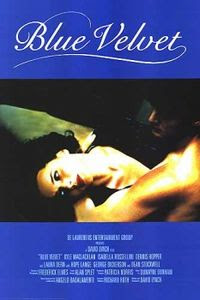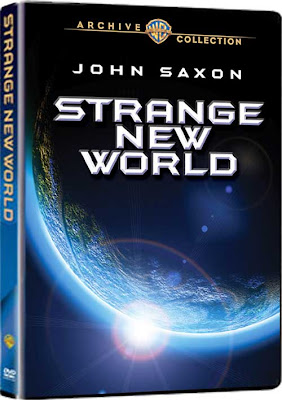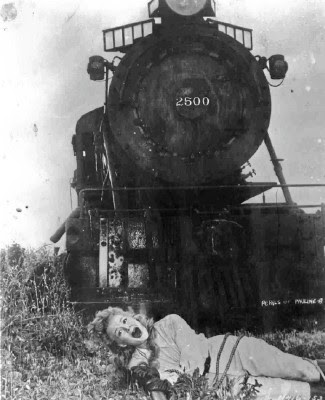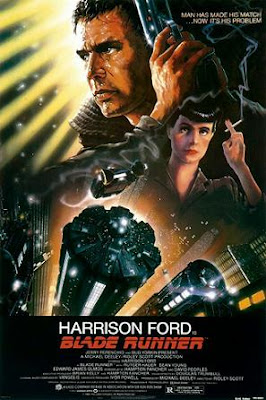And if you're not human, if you're a replicant, you aren't even little people. That's the core of the film's race-based argument. That mankind has played God by creating the Replicants but then steadfastly refused to acknowledge this creation, this child, with the very dignities we all cherish every day: equality and liberty.
Like all underclasses throughout history, the android replicants in Blade Runner are known by a derogatory slang term: skin-jobs. And replicants also have a built-in expiration date that make them seem less than fully human: they die four years after their "incept date."
As you may well imagine, this fact doesn't sit well with some of the Replicants, and that's what precipitates much of the action in the film. A cadre of Replicants return to Earth (from off-world) on a spiritual quest; on a search for more life that, in sub textual terms, might be interpreted as the search for racial equality.
Man Has Made His Match. Now It's His Problem.
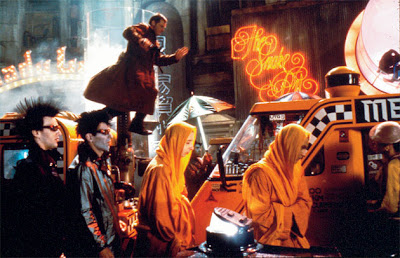 Specifically, Blade Runner revolves around the hunt and pursuit of six renegade replicants. Yep, I said six, and that's according to Los Angeles' police chief, Bryant (M. Emmet Walsh) in explicitly stated dialogue. This number is important to note, especially according to one specific reading of the film. But more on that later.
Specifically, Blade Runner revolves around the hunt and pursuit of six renegade replicants. Yep, I said six, and that's according to Los Angeles' police chief, Bryant (M. Emmet Walsh) in explicitly stated dialogue. This number is important to note, especially according to one specific reading of the film. But more on that later.
The man doing the hunting is the laconic, hard-boiled and lonely Deckard (Harrison Ford), a former detective in a special police squad called Blade Runners. Blade Runners are famous for "retiring" skin jobs.The quarry this time includes Leon (Brion James), Zhora (Joanna Cassidy), Pris (Daryl Hannah) and Roy Batty (Rutger Hauer). And yes, that's only four names, even though Bryant mentioned six replicants.
Over the course of his investigation, Deckard questions the latest model of Replicant, a new upgrade built by the Tyrell Corporation named Rachel (Sean Young). "More human than human" as the slogan goes, Rachel doesn't realize she's actually a machine. Rachel even boasts distinctive memories from her childhood. But these memories are really just clever implants; the memories of "Tyrell's niece."
Deckard soon falls in love with the winsome, confused Rachel and -- depending on which version of the film you see -- also experiences strange dreams of a unicorn in a primeval forest. After hunting down the last of the Replicants, Deckard must decide if he should pursue his relationship with a Replicant...
"I Think It Was Manufactured Locally:" 1980s Terrors Lurking in Los Angeles, 2019

Early in the 1980s, many citizens in the United States of America feared that the country had a new, powerful and sinister competitor: Japan.
At the time, that country excelled in industry, manufacturing, and the development of new technologies. Importantly, Japan was also the United States' main international creditor in this era and it benefited financially from a forty-to-fifty-billion dollar trade gap with the United States.
In particular, the Japanese auto industry seemed to be cleaning Detroit's clock. Seeing this, many World War II veterans who had fought in the Pacific and had witnessed the Draconian, brutal behavior of the Japanese in a time of conflict perceived a danger.
As a character in Die Hard (1988) knowingly jokes, "Pearl Harbor didn't work" so Japan was taking over the United States economically: with "VCRs." There were many Americans of the Greatest Generation who felt precisely that way in the early 1980s (and my beloved, now-deceased paternal grandfather was one of them. Never bought a Japanese car. )
Although structurally and visually a deliberate reprise of the 1940s film noir (an era, incidentally of actual rather than economic war with Japan), one of Blade Runner's many undercurrents involves this 1980s incursion of Japanese business interests in future America.
In particular, it appears that in 2019 American business (always ahead of the curve....), has assimilated Japanese business interests into its very structure so as to continue turning huge profits and remain on the top of the food chain.
Or, as authors Douglas Kellner, Flo Leibowitz and Michael Ryan wrote in their essay, Blade Runner: A Diagnostic Critique (Jump Cut, February 1985, pages 6-8):
"Crowds of people mill through rain-soaked streets, evoking common fears about overpopulation and "foreigners" overrunning future cities. On the East and West coasts of the U.S., for example, Japanese ramen and sushi cafes have replaced U.S. fast food chains, and visibly prominent are many Asian merchants and street people. The film here seems to articulate paranoia about Japanese capitalism "taking over" the United States. Nevertheless, the film’s city (Los Angeles) seems under the hegemony of U.S. capitalism, which now seems to have incorporated its rivals into its structure. The society’s economic structure combines small, street-merchant-style, "free enterprise" with paternalistic capitalist control. Most of the merchants in the film are Asian or European, whereas the corporate president and executives of the Tyrell Corporation are all North Americans."
So Blade Runner acknowledges the timely fear of a Japanese take-over in America, but puts a spin on it. Even the resourceful Japanese have become slaves to a Corporatist Nation in the future.
Similarly, Replicants -- constructed piece-meal in Mom/Dad, Asian-controlled shops such as the Eye Factory run by Chew (James Hong) -- are another symbol of Big Business gone amok in the future of Blade Runner; of the consumer culture of the 1980s carried to the next level. It's a world where human beings use other beings (androids) for pleasure, to fight wars, and to perform menial tasks that humans apparently no longer wish to do.
And yes, this description uncannily mirrors how immigrants are viewed in today's American society. Interestingly, the film suggests that Big Business will go along with a new influx of workers from other nations, and even co-opt that work force so to stay on "top," literally ,of the situation (living high, high above it, in palatial skyscrapers). If you look at the big companies hiring undocumented workers today, one detects that this speculation was not very far off the mark.
"Is This to Be An Empathy Test?" A Replicant Civil Rights Movement in Blade Runner

In an era of world war, a dedicated drive towards equality for all U.S. citizens was begun here at home.
The 1940s was the era of Roosevelt's Executive Order 8802, which opened up new job possibilities for African-Americans. It was also the era in which white-only primaries were judged unconstitutional by the Supreme Court.
The noir era in film was also the age of Truman's National Committee on Civil Rights, CORE (Congress of Racial Equality), and the election of Chicago's William Dawson in the House of Representatives. There was still a long way to go, but the a long march towards equality was beginning.
Blade Runner explicitly discusses race and the history of race inequality in America. As I noted above, it speaks in the film language (noir) of the 1940s, an era when race was a concern in the United States as enumerated above.
More than that,the Replicants are described in historically racist terms, ones involving the nature of their skin, not the quality of their character. They are not "colored" or "negro," but "skin-jobs. Replicants are not considered "fully" human, and again, this reflects our history. In 1789, in the Constitution, African-Americans were considered 3/5s of a person...not the equivalent of a white person, in other words. If you see someone as being less than fully human, that makes it much easier to enslave them, to deny them basic human rights. In the film, Roy Batty acknowledges this and contextualizes his experience, and the experience of the Replicants, as slavery. He discusses with Deckard what "it is to be a slave."
I suppose there is no need to describe Deckard's hunt of the Replicants as a "high-tech lynching" but certainly, the Replicants are treated harshly as a matter of course in 2019. Deckard shoots Zhora in the back, exposing the ugly truth that Replicants have no legal rights in this society. They are not arrested and afforded due process of law. They are not innocent until proven guilty. Instead, Replicants are shot on sight because of what they are, not because of their conduct. This is the essential characteristic of institutional racism: denying people freedom not because of their behavior; but because of their origin, their skin color, their heritage. If you want to delve deeply into the visuals of Blade Runner, consider that Zhora is murdered while crashing through a series of invisible glass barriers, a metaphor, perhaps, for the oft-mentioned "glass ceiling" that keeps minorities from high level positions in society.
Leon attempts to kill Deckard and says to him, "painful to live in fear, isn't it?" And that too is part of the racial equation. For the Replicants, it's the knowledge that they can be shot and killed at anytime. For Latinos in Arizona today, it's the knowledge that you can be asked for your papers by armed police simply because of your skin color.
You can go pretty deep with this interpretation of the film, if that's your inclination. There's a test in Blade Runner for determining if a person is human or Replicant, and it is called a "Voigt-Kampff" Test. That name sounds uncomfortably like Hitler's manifesto Mein Kampf, doesn't it? And when we think of the Nazis, we think of the belief in racial purity, the subjugating of "lesser" races, right? The Voight-Kampf functions as a tool to identify one such lesser race, the Replicant.
And interestingly, what this test looks for is the "empathy" response in the iris, in the eyeball. As we know from President Obama's last Supreme Court battle, "empathy" is apparently a code word in America today. What Blade Runner doesn't make plain, however, is if Replicants possess a surfeit or lack of empathy in their iris responses.
But what's abundantly clear in Blade Runner is that Replicants are people too. They are, as the saying goes, more human than human.
They love, they mourn, and they want want all human beings want: more life (fucker!). In fact, the Replicants undergo a real spiritual quest in the film. They seek to find their God, Tyrell, and petition him for more life. They seek forgiveness from him too, at least after a fashion, for their methods of self-preservation. In answer, they are told by Tyrell, Corporate God, that they have done nothing "the God of biomechanics wouldn't let you into heaven for."
Of course, the Replicants then kill God, but the relevant point is that Replicants, like humans, seek to understand their very nature, and turn to the divine for that knowledge.
Roy Batty does more than that, however. He not only seeks answers from his God, but, ultimately, shows mercy to his enemies, which is something you cannot say for the police in Blade Runner. Batty could kill Deckard...but choose to save his life instead.
In this beautiful and emotionally-wrenching climactic scene, Batty is depicted grasping a white dove -- a representation of the Holy Spirit in Christian Mythology -- and a symbolic signifier that Batty is truly one of God's creatures and, through his mercy, has earned the right to be considered such. When the dove flies Heavenward, released by Batty, the image visually suggests that Batty's soul has fled his body; that he was more than just a machine.
You've Done A Man's Job, or Less Human Than Human: The Deckard Equation

One of the key questions regarding Blade Runner involves its protagonist, Deckard. Director Ridley Scott has suggested that Deckard is, in fact, a Replicant himself. Harrison Ford has gone on record as saying he believes Deckard is human.
As in all great art, a case can probably be made either way.
If Deckard is a Replicant, then he is clearly "passing" as a human being, and that seems to fit in with the film's racial overtones.
Indeed, there are passages of dialogue in the film that hint at Deckard's Replicant nature. In particular, Gaff (Edward James Olmos) tells Deckard after Batty is dead that the blade runner performed a "man's job." In other words, a job worthy of a man, or a human being. So this description could be interpreted to mean that the replicant has performed as well as a human would under similar circumstances. It is thus a race-centric remark (Hey, you did good for a black guy!) and thus an acknowledgment of Deckard's genetic origin.
Also, Gaff leaves behind at Deckard's apartment a small origami Unicorn. And, in the director's cut of Blade Runner, Deckard dreams of a unicorn in the forest. If Gaff is aware that all Replicants are encoded with the unicorn dream as part of their unusual genetic make-up, then he has left behind the origami unicorn to let Deckard understand the truth about himself. If only Deckard can put it all together...
In the final battle at the Bradbury building, Batty also says to Deckard "let's see what you're made of," as if there is a question about Deckard truly is made of, genetically-speaking. Well, what is Deckard made of?
The following fight scene suggests that our hero is made of much the same stuff as Batty. Notice that in the ensuing fight, Scott's camera catches both Deckard and Batty mending damaged hands at roughly same time, through the art of cross-cutting, This could be a subtle, visual connection. Both men share something in common: an injury. On one level this could simply be an indication that a Replicant boasts the same survival instinct as a human does. On another level, it could mean that these men share a different kind of "kinship," - Replicant-hood, if that's a word. Also, it's important to note that both Batty and Deckard are slaves, though in service of different masters. But this too could be interpreted either way. To demonstrate, perhaps, that the gulf between human and Replicant is not so wide; or more pointedly, to sub-textually suggest that both men are Replicants.
Lastly, remember that Bryant discussed six free replicants, yet the movie reveals depicts four Replicants, and notes that one (the fifth?) was killed attempting to cross a border, a fence (which again, reeks of racial connotations). That leaves one replicant, right? So who is the sixth and final Replicant? Deckard? It can't be Rachel, because when Bryant tells the story of the six replicants to Deckard, Rachel has not yet left the custodianship of Tyrell.
Finally, the very form that Blade Runner utilizes -- the film noir detective story -- suggests Deckard's heritage. In the best film noir movies, the investigation by a detective leads, inevitably, to some shattering personal revelation. Consider Johnny Favorite's journey of self-discovery in a Blade Runner contemporary, Angel Heart (1987). Or the revelation by Faye Dunaway's character in Polanski's Chinatown (1974). In noir, we must conclude that the ultimate discovery is not who-did-it. Rather, it is "who am I?," the discovery or assertion of identity. If Deckard is indeed a replicant, than the film adheres more closely to the noir format. That's ultimately why I favor this interpretation; it's encoded in the film's very DNA.
On the other side of the equation, if Deckard is not a replicant, then, at the very least the film's racial overtones carry an optimistic message to go out on. If even a Blade Runner can fall in love with a Replicant, as Deckard does here, then there is hope yet for the human race. There is some hope of future equality for these artifical people.
But whether Deckard is a Replicant or a human, Blade Runner remains a brilliantly-conceived and wonderfully executed motion picture. By using the film noir approach, Ridley Scott's film creates not only a daring vision of the future, but subconsciously evokes a time period in America when racism was more up-front than it is today (Arizona notwithstanding). The film noir approach grants some breathing room for the film to contextualize the Replicant experience of 2019 in historical terms that we all understand and recognize.
Blade Runner is so packed with fascinating ideas and subtexts (like the quest for immortality; for example), that it's almost impossible to do the film any sort of justice in one blog post. So this review is hardly the last (or even second-to-last) word on the production.
As critic Rita Kempley wrote in The Washington Post (back in 1992): "Every viewing of "Blade Runner" brings new discoveries..."




